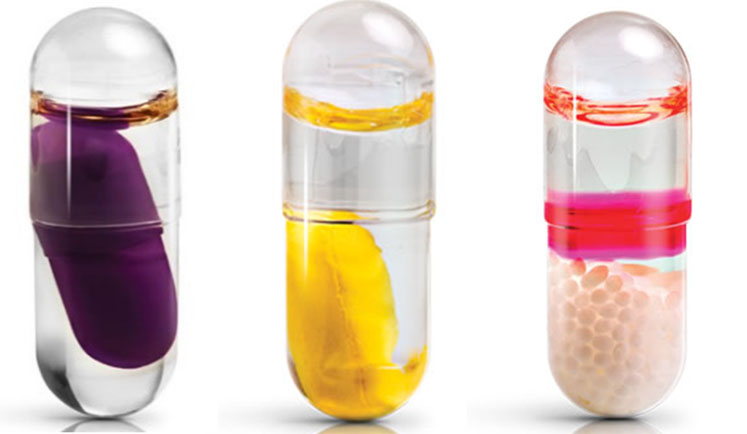Part II takes a closer look at both solid/solid and solid/liquid combinations in hard capsules. A hard capsule can encapsulate powders, pellets, mini/micro tablets or smaller capsules into a bigger capsule.
These combinations can contain multiple APIs to avoid the incompatibility challenges associated with certain drugs. A smaller capsule can be encapsulated in a bigger one, which can effectively separate the two incompatible molecules while having a synergistic effect.
Not only are incompatibility issues solved, but impurity generation owing to drug-drug interactions can also be avoided with a capsule-in-capsule combination because there is zero contact between the two drugs.
Depending on the formulation requirement, two or more actives can be combined in the form of pellets, micro-tablets or powders. This combination provides the option of a once-daily dose for patients to help prevent multi-drug resistance and missed treatments, leading to patient centricity.
Another benefit is that combinations of different release profile options can be achieved. For example, immediate release (IR) with extended release (ER) or delayed release (DR) forms can be achieved in a single capsule.
This can be accomplished by using multiple drug pellets with different coating levels to provide multiple drug release profiles. Mini- or micro-tablets offer higher accuracy in terms of weight variation, along with the possibility of different release profiles.
Innovations in capsule encapsulation machines have made it possible to fill a wide variety of combinations in a single dosage form (Figure 2). Some solid/solid combinations that can be given in hard capsules include the following:
- Aspirin tablet + Atorvastatin tablet (cardiovascular disorder)
- Aspirin pellets + Atorvastatin pellets + Clopidogrel pellets (cardiovascular disorder)
- Nitrofurantoin IR tablet + Nitrofurantoin SR tablet (urinary tract infection)
- Methyl cobalamin SR tablet + Pregabalin powder (neuropathic pain)
- Fenofibrate tablet + Tamsulosin pellets (benign prostatic hyperplasia)
- Dutasteride softgel + Tamsulosin pellets (benign prostatic hyperplasia)
- Tolterodine IR pellets + Tolterodine ER pellets (overactive bladder)
- Rifampicin + Isoniazid + Pyrazinamide mini-tablets (tuberculosis)
- Efavirenz + Emtricitabine +Tenofovir (HIV)
- Fluticasone + Salmeterol (respiratory disorder).

Figure 2: Solid/solid combinations in hard capsules
Solid/liquid combinations in hard capsules
Solid/liquid combination products can also be achieved with the help of liquid-filled hard capsules (Figure 3). These capsules have specifically designed locking mechanisms for liquid encapsulation.
Oils, liquids, and semisolids can be directly encapsulated in hard capsules. The possibilities for liquid filling include capsule-in-capsule, tablet-in-capsule and pellets-in-capsule.
These combinations have their own particular benefits. As an example, in the capsule-in-capsule form, one active can be in liquid form whereas the other can be encapsulated in a smaller capsule. These flexible solutions offer formulators unique ways to both increase the product lifecycle and deliver combination therapies.

Figure 3: Solid/liquid combinations in a single hard capsule
To cite some examples, in Liquid + Capsule forms, one active is a liquid, contained in an outer bigger capsule, whereas the other active is encapsulated in a smaller capsule. Conceptual examples include Artesunate + Amodiaquine and Arterolane + Piperaquine Phosphate.
In Liquid + Pellet forms, a drug in liquid form offers immediate release, whereas the pellets can provide modified release. Conceptual examples include Domperidone Maleate + Omeprazole DR pellets and Ibuprofen + Chlorpheniramine pellets.
Finally, in Liquid + Tablet forms, a drug in solution provides immediate release whereas one in tablet form can be DR or ER. Conceptual examples include Atenolol IR + Nifedipine SR tablet and Losartan Potassium + Amlodipine tablet.
Conclusion
The strategy to combine drugs in a single dosage form is one of the best ways for R&D leaders to increase the therapeutic efficacy of their medicine, reduce its side-effects, extend the product lifecycle and increase patient adherence.
Capsules are the most suitable choice of dosage form when it comes to the combination of two or more drug molecules. Through innovation and modification, and with the availability of encapsulation machines, as well as capsule options in multiple sizes, colours and different polymers, hard capsules have attained exceptional potential.
The myriad options and ongoing progress in combination fill technology have made FDC development an accessible and beneficial reality for many pharmaceutical companies.
References
- www.grandviewresearch.com/industry-analysis/pharmaceutical-manufacturing-market.
- www2.deloitte.com/us/en/insights/industry/life-sciences/pharmaceutical-industry-trends.html.
- www.drugpatentwatch.com/blog/the-importance-of-pharmaceutical-competitor-analysis.
- N. Yousefi, et al., “New Product Development in the Pharmaceutical Industry: Evidence from a Generic Market,” Iranian Journal of Pharmaceutical Research 16(2), 834–846 (2017).
- www.ncbi.nlm.nih.gov/books/NBK11774.
- www.pharmaceuticalonline.com/doc/fixed-dose-combination-drugs-why-and-how-0001.
- B. He, et al., “Combination Therapeutics in Complex Diseases,” Journal of Cellular and Molecular Medicine 20(12), 2231–2240 (2016).
- P. Torella, R. Chait and R. Kishony, “Optimal Drug Synergy in Antimicrobial Treatments,” PLOS Computational Biology 6(7): 10.1371/annotation/4117feb8-90b6-474f-aba8-0da4aa4b7c21.
- B. Blomberg, et al., “The Rationale for Recommending Fixed-Dose Combination Tablets for the Treatment of Tuberculosis,” Bulletin of the World Health Organization 79(1), 61–68 (2001).
- S. Alven and B. Aderibigbe, “Combination Therapy Strategies for the Treatment of Malaria,” Molecules 24(19), 3601 (2019).
- F. Iellamo, et al., “Practical Applications for Single Pill Combinations in the Cardiovascular Continuum,” Cardiac Failure Review 3, 40 (2017).
- R. Miranda, et al., “An 18-Week, Prospective, Randomized, Double-Blind, Multicenter Study of Amlodipine/Ramipril Combination Versus Amlodipine Monotherapy in the Treatment of Hypertension: The Assessment of Combination Therapy of Amlodipine/Ramipril (ATAR) Study,” Clin. Ther. 30, 1618–1628 (2008).
- S. Bangalore, et al., “Fixed Dose Combinations Improve Medication Compliance: A Meta-Analysis,” Am. J. Med. 120(8), 713–719 (2007).
Part I is available to read here.

